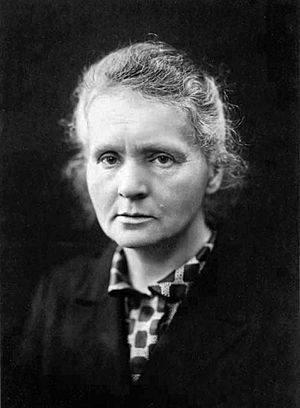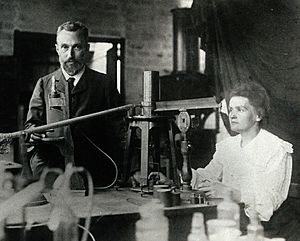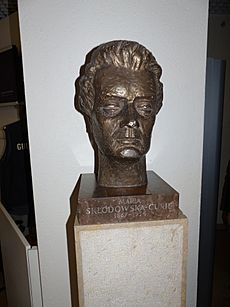Marie Curie facts for kids
Quick facts for kids
Marie Curie
|
|
|---|---|

Curie in 1920
|
|
| Born |
Maria Salomea Skłodowska
November 7, 1867 Warsaw, Congress Poland, Russian Empire
|
| Died | July 4, 1934 (aged 66) Passy, Haute-Savoie, France
|
| Cause of death | Aplastic anemia from exposure to radiation |
| Citizenship |
|
| Alma mater |
|
| Known for |
|
| Spouse(s) | |
| Children |
|
| Awards |
|
| Scientific career | |
| Fields | Physics, chemistry |
| Institutions |
|
| Thesis | Research on Radioactive Substances |
| Doctoral advisor | Gabriel Lippmann |
| Doctoral students |
|
| Signature | |
Marie Curie (born November 7, 1867 – died July 4, 1934) was a brilliant Polish and French physicist and chemist. She is famous for her groundbreaking work on radioactivity. Marie Curie was the first woman to become a professor at the University of Paris. She was also the first woman ever to win a Nobel Prize. Even more amazing, she was the first person to win two Nobel Prizes! She won one in physics in 1903 and another in chemistry in 1911. Her physics Nobel was for her research into radiation, which was first discovered by Henri Becquerel.
Sadly, Marie Curie died because she was exposed to too much radiation in her laboratory. At the time, scientists didn't know how dangerous radiation was, so she had no protection.
Contents
Early Life and Education
Marie Sklodowska Curie, whose birth name was Maria, was born on November 7, 1867, in Warsaw, Poland. She lived there until she was 22 years old. Marie was the youngest of five children. Both of her parents were teachers, and Marie was very smart.
However, she had a tough childhood. Her older sister, Zofia, died from typhus in 1876. Just two years later, when Marie was ten, her mother also passed away.
From a young age, Marie was fascinated by physics. She finished high school at fifteen, at the very top of her class. To earn money for her studies, Marie became a teacher. She dreamed of going to school in Paris, France. She also attended an unofficial college in Poland called the Flying University, which secretly allowed women to study. Eventually, she moved to France, living with her sister and brother-in-law, and started using the name "Marie." In Paris, she earned advanced degrees and did important scientific work. Later, she helped create the Curie Institutes in Paris and Warsaw.
Family Life
Even though Marie became a French citizen, she always felt connected to her Polish identity. She graduated first in her class from the University of Paris in 1893. A year later, she earned a master's degree in mathematics.
She met her future husband, Pierre Curie, at the Municipal School of Industrial Physics and Chemistry. They got married a year later and began working together on scientific discoveries. Marie and Pierre had their first daughter, Irène, in 1897. Their second daughter, Ève, was born in 1904. Sadly, Pierre died on April 19, 1906, after being hit by a horse-drawn wagon.
Discoveries in Physics and Chemistry
Marie and her husband developed the idea of radioactivity, a term they created. They also found ways to separate radioactive isotopes. Their research led to the discovery of two new elements: polonium and radium. Marie named polonium after her home country, Poland.

In 1898, the Curies, along with Gustave Bemont, discovered radium. They were studying a uranium ore that gave off a lot of radiation. They realized this radiation was coming from more than just uranium. This led them to find radium within the ore.
Curie used her knowledge of radioactivity to create new ways to treat cancer. These treatments used radioactive isotopes. Even today, doctors use radiation therapy to treat certain cancers. During World War I, Curie developed portable x-ray machines, nicknamed "Petite Curies" (Little Curies), to help wounded soldiers on the battlefield.
Winning the Nobel Prizes
In December 1903, the Royal Swedish Academy of Sciences awarded the Nobel Prize in Physics to Pierre Curie, Marie Curie, and Henri Becquerel. They received it for their amazing research on radiation discovered by Professor Henri Becquerel.
At first, the committee only planned to honor Pierre Curie and Henri Becquerel. However, a committee member who supported women scientists, Swedish mathematician Magnus Gösta Mittag-Leffler, told Pierre about this. After Pierre complained, Marie's name was added to the nomination. This made Marie Curie the first woman ever to win a Nobel Prize!
Marie and Pierre decided not to go to Stockholm to accept the prize in person. They were too busy with their work, and Pierre didn't like public ceremonies and was feeling unwell. Nobel winners had to give a lecture, so the Curies finally made the trip in 1905. The money from the award allowed them to hire their first laboratory assistant.
After winning the Nobel Prize, the University of Paris offered Pierre Curie a professorship and a physics department chair. However, they still didn't have a proper laboratory. After Pierre complained, the University of Paris agreed to build a new lab, but it wasn't ready until 1906.
Later Life and Legacy
After World War I, Marie started raising money for more radiation research. She was invited to tour the United States in 1921 to help speed up her research. She collected enough money and equipment for a new laboratory. Marie became a celebrity, speaking at many meetings to raise funds. She also supported world peace by serving on the council of the League of Nations.
Marie Curie's Death
Around the 1920s, Marie Curie and many of her colleagues started showing signs of illness. Curie began to lose her sight, and eye surgeries didn't help. She suspected that the radium she discovered might be causing her health problems, but she found it hard to admit this to herself or others.
In the early 1930s, Curie’s health quickly got worse. Doctors diagnosed her with pernicious anemia, a blood condition caused by too much radiation exposure. The doctors kept the full details from the public and from Curie herself.
On July 4, 1934, at 66 years old, Marie Curie died in a sanatorium (a special medical facility for long-term illnesses) in the French Alps. She was buried next to her husband in Sceaux, France.
Marie Curie was known for being honest and living a simple life. Her amazing scientific work changed the world. She is still one of only four people in history to win two Nobel Prizes.
Famous Quotes from Marie Curie
- "Be less curious about people and more curious about ideas."
- "You cannot hope to build a better world without improving the individuals. To that end, each of us must work for his own improvement."
- “Nothing in life is to be feared, it is only to be understood. Now is the time to understand more, so that we may fear less.”
- “I am among those who think that science has great beauty.”
- “You must never be fearful of what you are doing when it is right.”
- “Radium is not to enrich any one. It is an element; it is for all people.”
- “First principle: never to let one’s self be beaten down by persons or by events.”
Interesting Facts About Marie Curie
- Marie attended Flying University, a secret college that illegally welcomed female students. It had to move often to avoid authorities.
- She was the first woman in Paris to earn her doctorate degree.
- Much of her lab work was done in a shed. A chemist once described it as "a cross between a stable and a potato shed."
- Five people in Marie's family have won a Nobel Prize.
- Marie's notebooks are now kept in lead-lined boxes because they are still radioactive.
- Marie invented portable x-ray machines, called "petite Curies," to help soldiers during World War I.
Honors and Cultural Impact

Marie Curie is one of the most famous scientists in history. She has received many honors and is celebrated worldwide, even in pop culture. Many universities around the world have given her honorary degrees.
Marie Curie was the first woman to win a Nobel Prize, the first person to win two Nobel Prizes, the only woman to win in two different science fields, and the only person to win in multiple sciences. Some of her awards include:
- Nobel Prize in Physics (1903, with her husband Pierre Curie and Henri Becquerel)
- Davy Medal (1903, with Pierre)
- Matteucci Medal (1904, with Pierre)
- Nobel Prize in Chemistry (1911)
- Franklin Medal (1921)
Many things have been named after Marie Curie:
- The curie (symbol Ci), a unit of radioactivity, is named in honor of her and Pierre Curie.
- The element with atomic number 96 was named curium (symbol Cm).
- Three radioactive minerals are also named after the Curies: curite, sklodowskite, and cuprosklodowskite.
- The Marie Skłodowska-Curie Actions fellowship program for young scientists in the European Union is named after her.
- In 2007, a metro station in Paris was renamed to honor both Curies.
- The only Polish nuclear reactor in operation, the research reactor Maria, is named after her.
- The 7000 Curie asteroid is named after her.
Marie Curie has also been the subject of several films:
- 1943: Madame Curie, an American film starring Greer Garson.
- 2016: Marie Curie: The Courage of Knowledge, a European film starring Karolina Gruszka.
- 2019: Radioactive, a British film starring Rosamund Pike.
Related Pages
Images for kids
-
Birthplace, ulica Freta 16, Warsaw
-
Krakowskie Przedmiescie 66, Warsaw, where Maria did her first scientific work, 1890–91
-
At the first Solvay Conference (1911), Curie (seated, second from right) confers with Henri Poincaré; standing nearby are Rutherford (fourth from right), Einstein (second from right), and Paul Langevin (far right).
-
Marie and daughter Irène, 1925
-
1935 statue, facing the Radium Institute, Warsaw
See also
 In Spanish: Marie Curie para niños
In Spanish: Marie Curie para niños



















